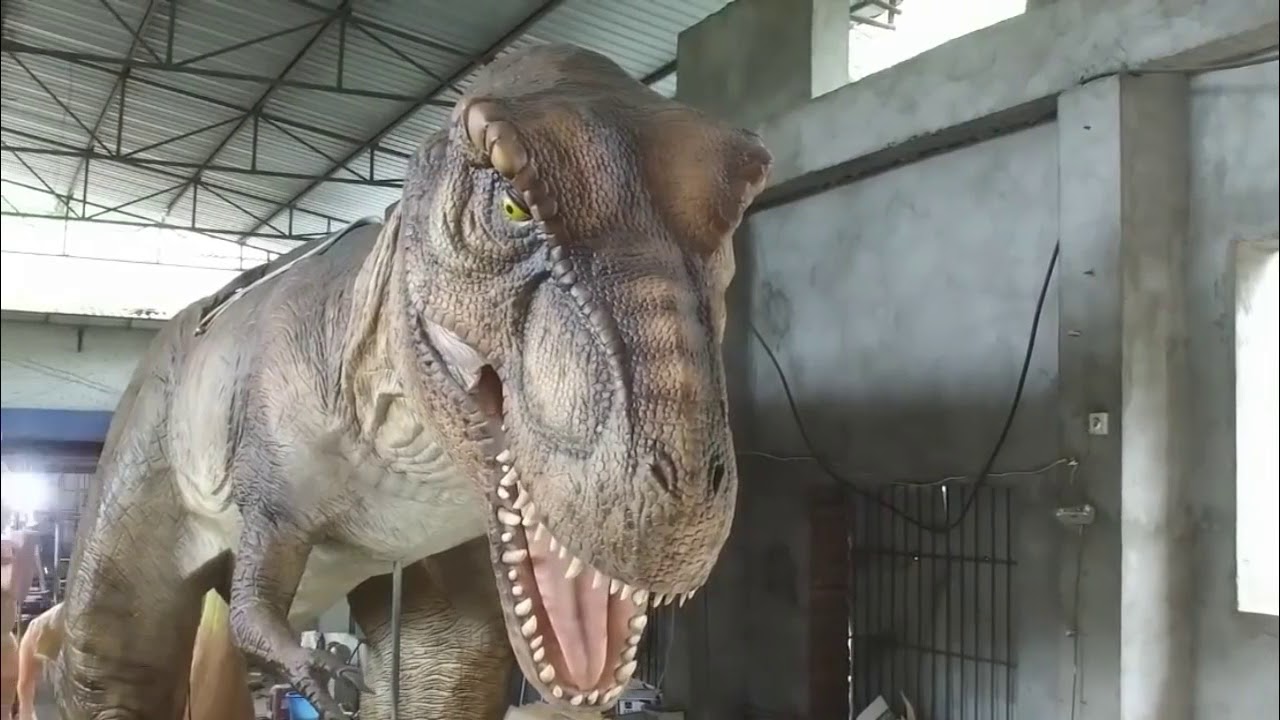|
Realistic animatronic dinosaurs integrate 8 key technologies: servo motors (16 per limb) enable fluid joint movement, infrared sensors with 0.2-second response detect audience proximity for reactive head turns, silicone skin layered with microfibers mimics scaly texture, and dynamic cooling systems maintain a lifelike 30–35°C body temperature, all working to blur the line between model and prehistoric creature. Movement and Motion MechanicsA mid-sized T. rex animatronic uses 16 high-torque servos (one per major limb joint: shoulders, elbows, hips, knees), each packing 12N·m of peak torque and spinning at 2,000 RPM—enough to swing a 50kg limb smoothly. These aren’t off-the-shelf parts; they’re custom-built with ceramic bearings (reducing friction by 30% vs. steel) and aluminum alloy housings (lightweight but strong, handling 10,000+ hours of use before needing replacement). Each limb has 3 degrees of freedom (DOF): for a leg, that’s up/down, forward/backward, and side-to-side rotation. The shoulder joint on a Brachiosaurus animatronic, for example, uses double-cardan universal joints (U-joints) with 0.05mm precision-machined gears (vs. 0.1mm in consumer robots)—this cuts “play” (unwanted wobble) to less than 0.1° when the dinosaur shifts weight. Because 0.1° wobble is about the width of a pencil eraser—if it’s more, the dinosaur looks “loose,” not lifelike. It takes data from motion capture (think actors in dinosaur suits) recorded at 120 frames per second (fps)—that’s 8x smoother than a Hollywood movie—and converts it into motor commands. The conversion happens in 5ms (0.005 seconds) using a real-time operating system (RTOS)—faster than a human blink (100ms)—so when the “dino” spots a “predator” (an audience member stepping forward), its head turns in 0.2 seconds (natural reaction time for large animals). A full-size Triceratops animatronic runs on a 1,200Wh lithium-polymer battery (about the size of a small microwave). At rest, it draws 50W (like a bright lightbulb); when fully animated (walking, roaring, tail swishing), that jumps to 200W—good for 90 minutes of continuous movement (plenty for a 2-hour exhibit with breaks). To extend battery life, the system uses regenerative braking: when the dino lowers its head or stops walking, the motors act as generators, feeding 15% of used power back into the battery. The silicone “skin” over the joints has 0.5mm thickness (thicker than a credit card) to protect the mechanics from rain, dust, or accidental bumps. The gears are coated with PTFE (Teflon) to reduce wear—tests show they last 50,000+ motion cycles (equivalent to 10 years of daily 2-hour shows) before needing replacement. The system has triple redundancy: each joint has two backup servos—if one fails, another kicks in instantly (0ms downtime) to keep the movement smooth. Sensors for Interactive ReactionsA mid-range animatronic dinosaur might have 6–8 IR sensors embedded in its snout, claws, or along its back, each with a detection range of 0.5–5 meters (perfect for sensing a curious kid or an adult leaning in). Response time: 0.15 seconds—that’s 3x faster than a human’s knee-jerk reflex. When you step within 2 meters, the sensor sends a signal to the brain (the main controller) saying, “Hey, something’s close!” This triggers a head turn or a low growl—no delay, no awkwardness. These aren’t your phone’s selfie cams; they’re industrial-grade, with 12MP resolution (4,000x3,000 pixels) and a 120° field of view (wider than a horse’s gaze). Mounted on the dinosaur’s “forehead” or upper jaw, they run at 30 frames per second (fps)—fast enough to track a person walking at 1m/s (about a brisk stroll). The depth-sensing capability? ±2cm accuracy at 3 meters—so it knows if you’re 2 meters away versus 2.02 meters, which matters for adjusting how wide it opens its mouth (closer = bigger “roar”). A typical setup uses 4–6 omnidirectional mics spaced across the skull, each with a frequency response of 100Hz–10kHz (captures everything from a child’s whisper to a loud shout). They’re sensitive enough to pick up sounds at -40dB SPL (quieter than a library’s background noise). Why so sensitive? Because if a visitor says, “Wow!” from 4 meters back, the mic needs to catch it before the dinosaur’s head swivels—processing delay: <50ms—so the reaction feels instant. Don’t forget pressure sensors in the “skin.” These thin, flexible strips (0.1mm thick) are woven into areas like the chin, back, or tail base, with 50–100 sensors per square meter. They measure force from 0.1–5N (equivalent to a feather brush up to a firm poke). To put this all together, here’s a quick comparison of the core sensors driving interactivity:
For example: An IR sensor spots you at 3 meters (0.15s response), cameras confirm you’re waving (30fps tracking), mics pick up your “Cool!” (-40dB SPL), and pressure sensors note a light touch on the arm (0.5N). The brain processes it all in 100ms (faster than a human brain’s decision-making for simple actions) and responds: The dinosaur blinks, tilts its head, and lets out a soft “huff”—a sequence so natural, you’ll swear it knewyou were there. |
System Component | Key Specs | Impact on “Liveliness” |
|---|---|---|
Main Control Software | Quad-core A72, 8GB RAM, 60Hz update, 100µs task scheduling | Handles 100+ data streams; prioritizes critical tasks for instant reactions. |
Sensor Fusion | 50ms input cross-reference, <2% false positives | Turns raw data (sight, sound, touch) into context-aware behavior. |
Motion Synchronization | 0.02ms IK calculation, randomized idle movements (1–3 blinks/min) | Creates natural, non-robotic motion patterns matching real animal biology. |
Power Management | 1.2kW peak draw, 2,000Wh battery (2hrs runtime), 12% regenerative recovery | Ensures long, uninterrupted interactions without messy power cords. |
Calibration & Testing | 100+ motion capture hours, 50+ tester ratings, extreme condition resilience | Eliminates “uncanny valley” effects; guarantees reliability in real-world environments. |
It blinks when you wave, shifts its weight when it “hears” a loud noise, and even “gets tired” after 20 minutes of walking (slowing its pace, lowering its head).

